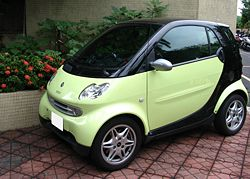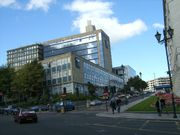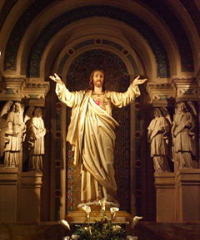Arrigo
Arrigo is an important city in Candelaria And Marquez, situated on the west coast of the secondary island in the Candelarias; Marquez, on the north bank of the Ensenada de la garganta. The inner city of Arrigo is just behind the harbour. The quarters of Ciudad Española, El Matthews and Rasgones del ángel surround this centre. Spanish colonisation of the Ensenada de la garganta area began in the mid- to late-eighteenth century; but the first recorded reference of a settlement of "Arrigo" is not found until 1804, where it is clearly described as part of a small Italian enclave. At what point the nascent town truly began its inexorable growth to become the islands’ largest city is uncertain, with early records of the city conspicuous by their near total absence. At any rate; by 1864 it was an important enough fishing port in Hispanic Marquez to be besieged by the British, and became an integral part of the new Dominion of the Candelarias from 1868. Cultural and economic life in the late-nineteenth century city revolved around fishing and shipbuilding; Arrigo’s denizens soon gaining a region-wide reputation as the best around in their chosen field. The steady decline of El din led many Spanish-speakers of all social backgrounds to move to Arrigo come the twentieth century, with the long-standing El periodico del Arrigo national newspaper becoming perhaps the best known representation of the city’s newfound status as the islands’ cultural hub of Hispanic Candelariasians. The city is also known for its unique, Latino-influenced, style of rap music called Oro oso (a name of unknown origin). However, though Spanish is considered the primary language of business and society in the city; it is seldom used as such though most schools emphasise Spanish over English. Indeed, the non-Hispanic (or 'Anglo') population narrowly outnumbers the native Spanish-speakers; while even the Latino element includes large numbers of Italian and Portuguese ancestry. Arrigo was the obvious choice to become capital of the short-lived Republic of Marquez, and it suffered badly from Socialist bombing during the Civil War; further enhancing the fiercely independent nature of its populous even after reintegration and establishment of modern C&M. Certainly Arrigo is an idiosyncratic city visually, retaining the white beaches of the west of Marquez and similarly pale buildings that give the city a distinctive, Iberian, feel. Traditional maritime activities remain important to Arrigo’s economy, though as typical for the cities on the Estrecho Innomado it is not to the extent of the pre-War era. The tertiary sector is the biggest employer, and there are also significant foreign info-tech plants; but the most notable single business is the Morales Automobile Company. Their rivals Patton-Carmichael also have several major assembly plants here. The modern city it also home to numerous minor national governmental departments, the embassies of Central Prestonia and South Thasland, and several major NGOs. Morales<div" class="plainlinksneverexpand"> </div>The entrepreneur Eduardo Morales is one of Arrigo’s most famous sons, being currently the Candelarias’ wealthiest man. A self-made millionaire; his original businesses were in waste disposal, used cars and later chassis, the latter a company soon bought out by Patton-Carmichael. Morales soon founded his own Morales Automobile Company, specialising in very cheap but reliable vehicles. Morales’ success has been based around his ability to stay consistently one step ahead of his rivals; predicting the country’s move towards environmentally-friendly regulations earlier than anyone and cornering the market in cheap, green family cars. As C&M government policy moves towards encouraging public transport, and pricing many more users of the roads; Patton-Carmichael and ClotaireAutos were among those shifting to primarily producing the relevant parts for trains and buses. Morales instead launched the Morales JCN (named for his mentor Juan Carlos Nogueira); an extremely cheap, small but green private vehicle that has become massively popular across Rushmore. The JCN now makes up around 70% of the company’s output, with its major plants being in Arrigo.
 The Morales JCN, a common sight as much across Rushmore as the Candelarias. Ed Morales is also involved in the world of motor racing, having been a founding member of the C&M AutoSportsSeries. He later became team principal of MPC Racing, an alliance with Patton-Carmichael that has appeared in the World Grand Prix Championship. FootballArrigo is not known as a sporting giant; perhaps because of its population’s preference for less structured activities, including dance. It is however home to Arrigo Portuguese FC, a storied club founded in 1937. After attaining the status of the city’s biggest, and only professional, outfit; the Heuva performed admirably in the national league without great tangible success, before fading away. Their return to the new CMSC provided a comedy of errors, including an ill-fated plastic pitch and a seemingly endless succession of managers. They are now, inevitably, bankrolled heavily by Edward Morales, and have seen greater success of late with promotion to the top-flight of the CMSC achieved in the XXV season through winning the second division, under coach Jay Zabojnik. They have been able to spend big to strengthen their slow but powerful team with international-standard quality; including Kura-Pelland's Iain Belling on the wings (with the hope of establishing a fruitful partnership of sorts with young Cortez Carocha), Zwangzug defensive midfielder Ursula Lauren and former C&M striker Steven Fritz. They have a current C&M Under-21 right-back in William Burgos, and a talented young striker in former A.Turks reject Kirby Brightmore. Veteran defender Nathaniel Ferraro will captain the side. As notable is their new stadium; the Estadio Arrigo National. Designed by Kura-Pellandi company ShinyPlaces, the new ground is set to open shortly before the start of the forthcoming season and be ready to house a certain number of C&M national team games early into the World Cup 38 qualifying campaign; should the CMSA approve its use.
According to the design team, "the design intentionally clashes old and new in a manner that provides a distinctive identity". The Velho or Viejo area of the stadium (above) mimics the design of the traditional Estadio Calle de Vitorero with a blue seated area of 10,400 seats intended primarily for visiting spectators, and a standing area with intended capacity of 10,125; the first such in the CMSC since the rules on such designs were relaxed. The moderno section (below) consists of two tiers of seating separated by executive boxes, with a distinctive glass roof and metallic trim, each tier having 11,264 seats, with an additional 1,060 executive box seats. An athletics track runs around the pitch; an introduction likely to be unpopular with supporters used to sitting as close to the players as possible, but deemed necessary to support the costs of the stadium by holding most of the country’s major athletics meets.
The University of Arrigo<div" class="plainlinksneverexpand"> </div>The Universidad Isabela González de Arrigo, or simply the "University of Arrigo’", is the third largest such body in C&M. It was not established as such until 1983, when it quickly came to superseded both the existing University (the "University of Lalla Bay") and the University of El din. Together with Albrecht University and Onwere University, it now forms part of the country’s triumvirate of elite tertiary education. It is named for a groundbreaking, Arrigo-born biochemist.
 The Faculty of Experimental Sciences; arguably the University’s most illustrious. The UoA is structured around four campuses in each of the city’s largest central districts;
The Sacred Heart Cathedral<div" class="plainlinksneverexpand"> </div>
 "Look, I am balancing invisible balls of fire. Love me, mortals!" By congregation the largest Roman Catholic Cathedral in the Candelarias, the hierarchy at the Sacred Heart (often referred to snidely as “Sacred Heart Liberals”) battle with the more conservative St. Joseph’s and the Blessed Peter Gonzalez (both of El din) for the hearts and minds of the country’s Catholic community. Inexplicably baroque, its two 50 metre-towers are prominent on the Arrigo skyline. |
|||||||||||||||



